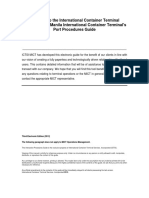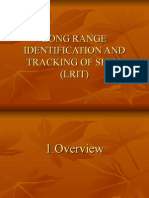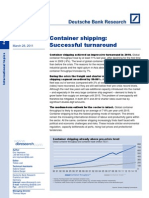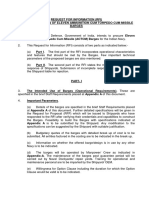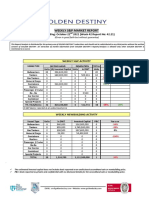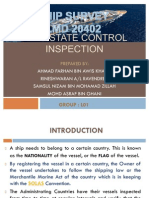SIMP Audit Guidance NOAA
SIMP Audit Guidance NOAA
Uploaded by
Limbania BelmanCopyright:
Available Formats
SIMP Audit Guidance NOAA
SIMP Audit Guidance NOAA
Uploaded by
Limbania BelmanCopyright
Available Formats
Share this document
Did you find this document useful?
Is this content inappropriate?
Copyright:
Available Formats
SIMP Audit Guidance NOAA
SIMP Audit Guidance NOAA
Uploaded by
Limbania BelmanCopyright:
Available Formats
GUIDE TO AUDIT REQUIREMENTS FOR THE
SEAFOOD IMPORT MONITORING PROGRAM: FREQUENTLY ASKED QUESTIONS
The Seafood Import Monitoring Program (SIMP) established permitting, reporting and recordkeeping
requirements for imports of certain seafood products in order to prevent illegal, unreported and
unregulated (IUU)-caught and/or misrepresented seafood from entering U.S. commerce, thereby
providing additional protections for our national economy, global food security and the sustainability of
our shared ocean resources. Currently, SIMP requires the importer of record to report key data in entry
filings for all import shipments of imported fish and fish products identified as particularly vulnerable to
IUU fishing or seafood fraud. In addition, importers must retain records of the information provided at
entry and additional chain of custody information sufficient to trace the fish from the point of entry into
U.S. commerce back to the point of harvest. These records must be retained, in paper or electronic
format, at the importer’s place of business for a period of two years from the date of import and must
be made available for inspection, including supporting an audit.
The National Marine Fisheries Service (NMFS) published a final rule establishing the Seafood Import
Monitoring Program (SIMP) on December 9, 2016. January 1, 2018 was the mandatory compliance date
for this rule. On April 24, 2018 NMFS published a final rule to include shrimp and abalone species in
SIMP with a mandatory compliance of December 31, 2018.
This document was developed in response to questions from importers regarding SIMP audit processes
and NOAA’s intent is to support industry compliance. This document does not offer any new
interpretation of the SIMP final rule or speak to potential enforcement actions which may result from
noncompliance with SIMP requirements, including noncompliance identified through the audit process.
As NMFS refines its auditing processes and additional questions from industry are raised, this guidance
will be updated.
OVERVIEW
The purpose of a SIMP audit is to verify the harvest and landing information provided in an entry filing as
well as the sufficiency of chain of custody records documenting the movement of fish and fish products
from harvest to the point of entry into US commerce. Importers will be notified in writing by a NMFS
auditor if an entry was selected for audit and asked to provide supporting records within 5-10 days,
depending on the format of submission. As a general rule, within thirty days of providing chain of
custody records to NMFS, auditees will be notified of audit results and, if necessary, any
nonconformities for the entry audited as well as corrective actions to support compliance of future
shipments.
National Marine Fisheries Service www.iuufishing.noaa.gov Page 1 of 9
TABLE OF CONTENTS
DEFINITION OF TERMS .................................................................................................................................. 2
CHAIN OF CUSTODY RECORDS AND INFORMATION ..................................................................................... 3
AUDIT PROCESS OVERVIEW .......................................................................................................................... 4
FREQUENTLY ASKED QUESTIONS .................................................................................................................. 5
ADDITIONAL RESOURCES .............................................................................................................................. 9
DEFINITION OF TERMS
ACE: The Automated Commercial Environment, managed by U.S. Customs and Border
Protection, is the primary system through which the trade community
electronically reports import data required by Federal agencies.
Auditee: An Importer of Record holding a current International Fisheries Trade Permit
with one or more entries) selected for audit under SIMP.
Chain of Custody: A series of records sufficient to trace the fish or fish products in an imported
shipment from the point of harvest to entry into US commerce, and at all points
in between, including individual or Aggregated Harvest Reports, documentation
of all movements of the fish, and identification of each custodian of the fish.
Information: Traceability data that describes documented or undocumented chain of custody
events provided to NMFS auditors.
Record: Documentation, in electronic or paper format, related to the harvest, landing,
transshipment, transfer or processing of fish and fish products subject to SIMP.
SIMP Data Set: The information, as specified at 50 CFR 300.324(b), that must be reported in
ACE at the time of entry for each entry containing species or species groups
subject to SIMP.
National Marine Fisheries Service www.iuufishing.noaa.gov Page 2 of 9
CHAIN OF CUSTODY RECORDS AND INFORMATION
For SIMP, a complete chain of custody tracks product from its initial wild-caught or aquaculture harvest
to the point of entry into U.S. commerce. Records to show this chain of custody should identify the
product and each custodian of the fish or fish product (e.g., a transhipper, processor, storage facility, or
distributor) at every step as that product moves through the supply chain.
NMFS may request additional information from the importer to assist in verifying the information
contained in chain of custody records provided. Additionally, NMFS may consult with other U.S. agencies
and foreign governments to verify the authenticity of documentation provided, subject to the strict data
confidentiality provisions applicable to SIMP.
NMFS intends to work with industry to support and improve compliance with SIMP, recognizing that the
program’s reporting and recordkeeping requirements became effective on January 1, 2018. For
example, NMFS developed SIMP model certificates for catch, processing and transshipment that were
widely disseminated in multiple languages to demonstrate to industry how required data might be
organized to facilitate entry filing. While these documents are records, the traceability information they
contain should be supported with other documentation (e.g., records from the harvester, country of
origin, shipper, storage facility or processor) or information to establish a verifiable chain of custody.
HARVEST AND LANDING DATA PROVIDED THROUGH ACE
The harvest and landing data elements reported at the time of entry filing through ACE will serve as
records that NOAA will verify if an entry is selected for audit. Should NMFS find that third party
verification of the harvest and landing data provided is insufficient or incongruous with other records,
auditors may request supplemental chain of custody records documenting the harvest and landing of
product, which the importer of record would need to make available.
CHAIN OF CUSTODY RECORDS
Per section 300.324(e) of the SIMP final rule, “In addition to the entry recordkeeping requirements
specified at 19 CFR part 163 and 300.323(b), the importer of record is required to maintain records
containing information on the chain of custody of the fish or fish products sufficient to trace the fish or
fish products from point of entry into U.S. commerce back to the point of harvest, including individual or
Aggregated Harvest Reports, if any, and information that identifies each custodian of the fish or fish
product (such as any transhipper, processor, storage facility or distributor). The latter may include
widely used commercial records such as declarations by the harvesting/carrier vessels or bills of lading.”
SIMP does not require the retention of specific records, offering industry the flexibility to use any
records sufficient to establish traceability through the supply chain from harvest to entry into U.S., such
as declarations by the harvesting/carrier vessels or bills of lading.
National Marine Fisheries Service www.iuufishing.noaa.gov Page 3 of 9
Some examples of records that may be used to establish chain of custody are listed in the table below:
HARVEST AND LANDING SHIPMENT RECORDS PROCESSING AND STORAGE
RECORDS RECORDS
Vessel Harvest Manifest Processor's Bill of Lading Daily Production Log
Records
Raw Material Invoice Processor Receiving Bill Finished Product Packaging Label
Fish Tickets at Landing Port Cold Storage Receiving Ticket Cold Storage Discharge Log
Off Loading Reports with Vessel Vessel Transferred Ticket Cold Storage Receiving Log
Name(s)
Country Catch Certificate Mate's Receipt Processor's Raw Material
Receiving Log
Proforma Invoice Transshipment Log Packing Log
Cold Storage Unloading Log
AUDIT PROCESS OVERVIEW
1. NMFS auditors will send a request for records pertaining to the entry(ies) selected for audit by email
to the designated International Fisheries Trade Permit (IFTP) holder, and may follow up with a call as
necessary. The IFTP Holder is required to report any changes in the information provided in the IFTP
permit application, including contact information, within 15 days of those changes going into effect; if
the change is not reported within 30 days, the permit is void as of the 30th day. See 50 CFR 300.322(k).
Importers can update this information through the NOAA Fisheries Permits website at
www.fisheries.noaa.gov/node/23406.
2. NMFS auditors are currently conducting SIMP audits through remote record review. The time frame
for auditees to provide requested chain of custody records to NMFS is as follows:
a. Five business days from receipt of the Audit notification if the auditee, IFTP Holder or
importer of record (IOR) choose to transmit the records via electronic means over e-mail
or using a secure file sharing service such as Accellion.
b. Ten business days from receipt of the Audit notification if the auditee, IFTP Holder or
IOR choose to transmit the records via secured shipping such as UPS, FedEx or U.S. Post
Office.
3. NMFS auditors will review submitted records and information for completeness. If the chain of
custody documentation is incomplete, NMFS will send a follow-up request for supplemental records to
the auditee, specifying key points in the supply chain where records are missing.
4. NMFS auditors will verify the adequacy and accuracy of traceability records and information provided.
5. NMFS will attempt to conclude audits within 30 days of receipt of records. Following the completion
of an audit, importers of record will receive a letter describing the outcome of the audit.
National Marine Fisheries Service www.iuufishing.noaa.gov Page 4 of 9
FREQUENTLY ASKED QUESTIONS
SIMP AUDIT PROCESS
Q. Will auditing always be post shipment?
A. No, per 50 CFR 300.324(d) , “[i]mport shipments of fish or fish products subject to this program may
be selected for inspection and/or the information or records supporting entry may be selected for audit,
on a pre- or post-release basis, in order to verify the information submitted at entry.” However, at this
time, NMFS is focused on conducting audits after the shipment has entered U.S. commerce.
Q: Why was my entry selected for audit?
A: SIMP entries may be subject to both random and targeted audits.
Q: Who will be contacted for an audit?
A: The holder of the International Fisheries Trade Permit (IFTP) will be contacted by a NMFS auditor
using the contact information provided on the IFTP permit application. The IFTP holder is also the U.S.
Importer of Record.
Q: Who is responsible for providing chain of custody records and information to NMFS auditors?
A: Based on the SIMP Final Rule, the auditee is responsible for providing the chain of custody records.
Q: What is the time frame for providing the chain of custody records to the auditors?
A: Chain of custody records must be retained in electronic or paper format, and made available for
inspection at the importer’s place of business for a period of two years from the date of import. For the
purposes of conducting audits, NMFS currently requests to receive electronic records provided within 5
days of notification, and hard copy records within 10 days of notification.
Q: Will the auditors be on-site? Or can the auditors conduct the audit remotely?
A: Records must be made available for immediate inspection at the importer’s place of business upon
request. In addition, NMFS conducts SIMP audits as remote records reviews and the auditor does not
need to be on-site at your facility. The requirements for providing digital records in five days and hard
copy records in ten days applies to remote record review audits.
Q: How and when will I know the result of an audit?
A: In most cases, auditees will receive notification of the results of an audit within 30 days of submission
of chain of custody records to NMFS.
National Marine Fisheries Service www.iuufishing.noaa.gov Page 5 of 9
HARMONIZED TARIFF CODES
Q: If I am importing a species that is not subject to SIMP but filed under a Harmonized Tariff Schedule
code that includes species that are subject to SIMP, could my entry be subject to an audit?
A: If an entry of a product under an HTS code covered by SIMP includes a species code that is not subject
to the full SIMP message set in ITDS, it is also not subject to the recordkeeping requirements of SIMP
and would therefore not be selected for audit.
Q: If I am importing a species that is subject to SIMP but filed under a Harmonized Tariff Schedule code
that is not subject to SIMP, could my entry be subject to an audit?
A: Importers are required to use the most specifically descriptive Harmonized Tariff Schedule code
available for any given entry; importers cannot legally circumvent SIMP requirements by using a non-
descript harmonized Tariff Schedule code. If an entry includes a species code that is subject to SIMP,
but the HTS code is not subject to the reporting and recordkeeping requirements of SIMP (such as for
highly processed products), the entry is not subject to SIMP and would therefore not be selected for
audit.
CHAIN OF CUSTODY RECORDS
Q: Which records are required for the chain of custody records?
A: The chain of custody records includes documentation of all points in the supply chain of the seafood
product, from point of harvest to entry into U.S. commerce (e.g., harvest, transshipment, landing,
processing, storage, distribution, export/re-export, and changes in custody. NOAA does not prescribe
what specific records are required because supply chains vary depending on a variety of factors
including fishery, product type, country of origin and producer. NOAA requires records sufficient to trace
each step from entry into U.S. commerce back to the harvest or production event. Chain of custody
records could include vessel product declarations, transshipment records, bills of lading, records on
processing, reprocessing, and co-mingling, changes in product ownership, and changes in product
location including storage, export/re-export and re-packaging.
Q: Are electronic or scanned copies of chain of custody records acceptable, or are original hard copies
required by NOAA for a SIMP audit?
A: Under SIMP, required records may be in electronic or paper format. A SIMP audit does not require
original records as long as the paper or electronic (digital) copies of the chain of custody records are
clear and legible.
Q. For electronic traceability systems - for example, software that tracks lot shipments from farm to
plant and from plant to importer - would NOAA accept the electronic transaction information as
sufficient (provided of course that the SIMP information is present), or is NOAA requiring records such
as a pdf or invoice?
A. Yes, electronic transaction information would be sufficient provided that the information required
under SIMP is present and verifiable.
National Marine Fisheries Service www.iuufishing.noaa.gov Page 6 of 9
Q: Some of my chain of custody hard copy records are required by a foreign government, so I do not
have access to them. What can I provide that will meet the SIMP audit requirements?
A: As stated above, records required under SIMP may be in paper or electronic format and original
records are not required for an audit. You should make and retain a copy of all required records prior to
submitting the originals to a foreign government. NOAA may work with foreign governments and
international organizations to verify traceability information provided to NMFS.
Q: What if the chain of custody records I can provide are not in English? Who is responsible for
translating the records?
A: NOAA Fisheries will translate records into English if needed, however it is the responsibility of the
auditee to explain how and to what extent the record describes a link in the chain of custody.
Q: How should I submit sensitive business information for an audit?
A: The data and records relating to the audit involving confidential and proprietary information will be
transmitted, accessed, and stored by the auditing organization under the Privacy Act and the current
USDOC policy on protection of Personally Identifiable Information (PII) and Business Identifiable
Information (BII). The process of secured transmission of the requested records for SIMP’s audit will be
advised to the auditee at the time of the audit notification.
Q: What if I, as an auditee, am not privy to the sensitive business information from other companies in
the supply chain?
A: SIMP is intended to ensure that importers of record are able to verify the legal origin of the products
they are importing. This would require some degree of access to information describing each step in the
chain of custody by the importer.
RECORDS ASSOCIATED WITH HARVEST AND LANDING
Q: What different chain of custody records will I need for small harvester vessels vs. large harvester
vessels?
A: The data elements reported at the time of entry filing through ACE will serve as records that NOAA
will use to verify harvest and landing if an entry is selected for audit, regardless of vessel size. In all
cases, chain of custody records beyond harvest and landing to the point of entry into U.S. commerce are
required.
Q: If the harvest vessel is registered under a Regional Fisheries Management Organization (RFMO)
and we access information related to the vessel’s authorization directly from the RFMO’s website, will
this information satisfy the SIMP requirement or do we have to keep the fishing license of each vessel
we purchase fish from on file?
A: Information obtained from the RFMO’s website will suffice, as long as the verification information
includes name of the vessel, fishing gear or method, type of fish, validity, flag state, and vessel
registration number but that information needs to be retained by the IFTP holder.
National Marine Fisheries Service www.iuufishing.noaa.gov Page 7 of 9
Q: Some catch log books and observer reports are directly sent by the vessel owner and observer to a
Regional Fisheries Management Organization and it is not current practice for the vessel owner to
provide the auditee/importer/buyer with this information. Is it mandatory that the auditee have these
specific records on file for a SIMP audit, or is there any other records sufficient to prove the catch is not
IUU?
A: SIMP does not required retention of any specific records, but does required retention of records
sufficient to document the chain of custody. NOAA Fisheries would first attempt to verify harvest and
lading information provided to NMFS through the entry filing message set. In verifying entry
information, NMFS may engage external parties such as a Regional Fisheries Management Organization
concerning the details and legality of the harvest events reported. In addition, records a vessel owner
may have such as Captains’ statements may include traceability information that could also be used to
verify harvest events and as needed could be requested of the auditee.
Q. Is cold storage considered a “custodian” or “owner” of the product and will they then have to
supply SIMP related transactional data?
A. Cold storage would be considered to be a custodian of the product so the auditee would need to
retain and provide chain of custody records such as receiving, storage, and shipping records under the
SIMP Rule.
Q: For fish which is stored in a cold storage facility then transferred to a carrier vessel or refrigerated
container to the final destination, will a receipt from the cold storage or declaration of transfer letter
or self-certified letter of fish transfer from the cold storage to the shipper be sufficient to satisfy SIMP
audit requirements?
A: Yes, receipts from cold storage that list the amount that is received and transferred are acceptable.
However, the Bill of Lading issued by the shipping company or the carrier vessel would also be required
as one of the chain of custody records.
Q: For tuna, why can’t the SIMP auditors look at and get all the information from the Tuna Tracking &
Verification records that are uploaded into ITDS?
A: Traceability information provided to NMFS through other trade monitoring programs may serve as
records. The NOAA 370 Form may provide the following information about the harvest event: harvest
weight, catch area, fishing gear, flag vessel, vessel names, and landing dates; as well as some chain of
custody information such as the name of the exporter and importer.
Q: Will auditors ask for documentation of small-scale harvest events?
A: Given provisions for small-scale fisheries under SIMP, NMFS will not ask for a record verifying the
details and legality of individual small-scale harvests, but auditors will ask for records beginning at the
point of aggregation, which may include records of deliveries or sale from the aggregator to a
processor or shipper listing the products harvested.
National Marine Fisheries Service www.iuufishing.noaa.gov Page 8 of 9
POST-AUDIT
Q: What enforcement actions could be taken if there are issues with the completeness or accuracy of
the chain of custody records I provided to NOAA Fisheries?
A: Noncompliance with the recordkeeping requirements of SIMP constitutes a violation of the
Magnuson-Stevens Fishery Conservation and Management Act and is subject to enforcement action.
The Magnuson Act authorizes monetary penalties and permit sanctions for violations of the Act and its
implementing regulations; the action that might be taken in any particular case will depend on a number
of factors including the nature and gravity of the violation and the violator’s degree of culpability and
history of prior violations. More information about NOAA enforcement actions, including the NOAA
Penalty Policy, is available on the NOAA Office of General Counsel Enforcement Section website:
http://www.gc.noaa.gov/enforce-office.html.
Q: If a SIMP audit results in a finding that my import shipment contained illegal seafood; will NOAA
Fisheries provide me with the finding so that I can address the issue?
A: NOAA Fisheries will provide the auditee with the finding. The information will also be referred to the
NOAA Fisheries Office of Law Enforcement for further action, as appropriate.
RESOURCES
This guide as well as a wealth of additional information regarding the Seafood Import Monitoring
Program is available online at www.iuufishing.noaa.gov.
The SIMP requirements are codified at 50 CFR 300.320-300.325
CONTACT US
Technical support and general questions regarding compliance can be directed to SIMP Support:
Email: SIMPsupport@noaa.gov
Phone: TOLL: 301-427-8301 TOLL FREE (US and Canada): 833-440-6599
Other questions or feedback may be directed to Celeste Leroux, NOAA Fisheries Office of International
Affairs and Seafood Inspection at Celeste.Leroux@noaa.gov.
National Marine Fisheries Service www.iuufishing.noaa.gov Page 9 of 9
You might also like
- Fisheries Law Enforcement Manual of Operation: (Flemo)Document164 pagesFisheries Law Enforcement Manual of Operation: (Flemo)Archie valdemorNo ratings yet
- PCG MC 02-2006Document10 pagesPCG MC 02-2006CG PO3 MARK ANTHONY A CRUZNo ratings yet
- ISM-IsPS Pocket Checklist - Revision 2Document18 pagesISM-IsPS Pocket Checklist - Revision 2sergiy100% (4)
- FAR-AMT 2021: Federal Aviation Regulations for Aviation Maintenance TechniciansFrom EverandFAR-AMT 2021: Federal Aviation Regulations for Aviation Maintenance TechniciansRating: 5 out of 5 stars5/5 (2)
- CTPAT Security Profile Questions - AirCarriers January 2020Document99 pagesCTPAT Security Profile Questions - AirCarriers January 2020lezaa23No ratings yet
- Export ProcedureDocument24 pagesExport Proceduresd_logeshNo ratings yet
- SIMP Audit Guidance 2020Document10 pagesSIMP Audit Guidance 2020haris.danuNo ratings yet
- Seafood Import Monitoring Program - SOPDocument9 pagesSeafood Import Monitoring Program - SOPJuan José MontoyaNo ratings yet
- FAC 238-1 Issued October 10, 2013Document5 pagesFAC 238-1 Issued October 10, 2013macmoo_dizonNo ratings yet
- CC2022Document593 pagesCC2022medillo.mssNo ratings yet
- Federal Register / Vol. 81, No. 55 / Tuesday, March 22, 2016 / NoticesDocument13 pagesFederal Register / Vol. 81, No. 55 / Tuesday, March 22, 2016 / NoticesMarketsWikiNo ratings yet
- Aqua One Center: (An ICT Enabled Aquaculture Support Service)Document7 pagesAqua One Center: (An ICT Enabled Aquaculture Support Service)Sunil MecheNo ratings yet
- FSMA TraceRule SeafoodSupplyChainExample 11042022Document3 pagesFSMA TraceRule SeafoodSupplyChainExample 11042022Robert HeSNo ratings yet
- Port ProceduresDocument50 pagesPort ProceduresPaul Saquido CapiliNo ratings yet
- FAO No. 195 S. 1999Document8 pagesFAO No. 195 S. 1999Jacqueline ChoiNo ratings yet
- Bfar CC 02292024-1Document777 pagesBfar CC 02292024-1dav30nbsNo ratings yet
- 195 - ImportationDocument8 pages195 - Importationkimsitchon11No ratings yet
- USCG 2019 0038 0003 - ContentDocument3 pagesUSCG 2019 0038 0003 - ContentelchocoNo ratings yet
- PSC InspectionDocument217 pagesPSC InspectionBinoj100% (1)
- Understanding and Implementing Catch Documentation Schemes: A Guide for National AuthoritiesFrom EverandUnderstanding and Implementing Catch Documentation Schemes: A Guide for National AuthoritiesNo ratings yet
- Importers Record D17!1!21-EngDocument5 pagesImporters Record D17!1!21-EngStillward Laud Mark-Mills0% (1)
- Resolution On Iattc Bigeye Tuna Statistical Document ProgramDocument11 pagesResolution On Iattc Bigeye Tuna Statistical Document ProgramNur Rokhmat FauziNo ratings yet
- 193 Circular Electronic BooksDocument5 pages193 Circular Electronic BooksizirishakNo ratings yet
- Technical Circular No41Document2 pagesTechnical Circular No41Str IZMNo ratings yet
- Gulf of Mexico Fish Farming Proposed RulesDocument45 pagesGulf of Mexico Fish Farming Proposed RulesbblochnolaNo ratings yet
- West Coast Observer WaiverDocument3 pagesWest Coast Observer WaiverDeckbossNo ratings yet
- DENR MO 99-20 Registration, Harvesting, Transport of Timber From Private PlantationsDocument5 pagesDENR MO 99-20 Registration, Harvesting, Transport of Timber From Private PlantationsMayette Rose Sarroza89% (9)
- Bush Et Al 2016 - Private Provision of Public InformationDocument6 pagesBush Et Al 2016 - Private Provision of Public InformationmymoghaneNo ratings yet
- Marpol Annex II Revisions 2007Document4 pagesMarpol Annex II Revisions 2007laurentiuNo ratings yet
- BEQ Consolidated PDFDocument117 pagesBEQ Consolidated PDFShiv RanjanNo ratings yet
- RA 9162 IRR Traditional VarietyDocument13 pagesRA 9162 IRR Traditional VarietyJerry SerapionNo ratings yet
- Week 11 SHP 303Document77 pagesWeek 11 SHP 303denverbaluyot5No ratings yet
- TRACEABILITYDocument6 pagesTRACEABILITYsanilNo ratings yet
- Global Review of Safety at Sea in The Fisheries SectorDocument134 pagesGlobal Review of Safety at Sea in The Fisheries SectordutvaNo ratings yet
- 18 Permen-Kp 2018Document35 pages18 Permen-Kp 2018Mawaddah RenhoranNo ratings yet
- NAV 3 Lesson 5 Keeping A LogDocument8 pagesNAV 3 Lesson 5 Keeping A LogMico Santos100% (1)
- Mammal Examiners Guide - 2024 FinalDocument61 pagesMammal Examiners Guide - 2024 Finaljeanylyn anacanNo ratings yet
- MARPOL A5 Checklist 2ppDocument2 pagesMARPOL A5 Checklist 2ppAhmad Aslam MohamadNo ratings yet
- Chek List Ilo MLC GuideDocument18 pagesChek List Ilo MLC GuideFédyHamdiNo ratings yet
- MN-5-034-1 - Safety Inspection ProgramDocument4 pagesMN-5-034-1 - Safety Inspection ProgramcatalinNo ratings yet
- Chek List Ilo MLC GuideDocument18 pagesChek List Ilo MLC GuideFédyHamdiNo ratings yet
- Fleet Notice 119Document2 pagesFleet Notice 119George100% (1)
- 31 Exist Sec MeasDocument42 pages31 Exist Sec MeasIbrahim KashmNo ratings yet
- Sanctions - Recent Deceptive PracticesDocument6 pagesSanctions - Recent Deceptive Practicessb5791No ratings yet
- Minimum Document Requirements PolicyDocument27 pagesMinimum Document Requirements Policymohamed nageebNo ratings yet
- MGN 272 (M) : Voyage Data Recorder'S (VDRS) - Performance TestingDocument6 pagesMGN 272 (M) : Voyage Data Recorder'S (VDRS) - Performance Testingaakash9090No ratings yet
- MMC 193 Voluntary Use of Electronic Books Dic Doc 5 MarzoDocument6 pagesMMC 193 Voluntary Use of Electronic Books Dic Doc 5 Marzorajesh.purkar9378No ratings yet
- Bahamas Marine Notice 93Document8 pagesBahamas Marine Notice 93Xyde JavNo ratings yet
- Shipmasters Information Booklet July 2020Document25 pagesShipmasters Information Booklet July 2020RomanNo ratings yet
- Long Range Identification and Tracking of Ships (Document66 pagesLong Range Identification and Tracking of Ships (YYN100% (1)
- Week 2c Log EntriesDocument63 pagesWeek 2c Log Entriesshahrior.aetNo ratings yet
- CH 04 Record KeepingDocument7 pagesCH 04 Record KeepingAmit PandeyNo ratings yet
- Protocolo Mango - JapónDocument7 pagesProtocolo Mango - JapónPaul Zevallos HuertoNo ratings yet
- Fao FinalDocument12 pagesFao Finalblacklist blackNo ratings yet
- Best Practices Shipping DocumentationDocument11 pagesBest Practices Shipping DocumentationgtoquirozNo ratings yet
- Annex 1 Kep BKIPM 37 - 2017 PDFDocument39 pagesAnnex 1 Kep BKIPM 37 - 2017 PDFAndi WibowoNo ratings yet
- Simp Model Catch CertificatesDocument9 pagesSimp Model Catch CertificatesRaquel VallejosNo ratings yet
- Datastewardship Finalproject LaurinoDocument4 pagesDatastewardship Finalproject Laurinoapi-437952389No ratings yet
- Fao On Licensing & Registration 198-1Document15 pagesFao On Licensing & Registration 198-1Eric Sison100% (2)
- MSC-FAL 1circ 2Document5 pagesMSC-FAL 1circ 2ehbeckmanNo ratings yet
- Techno-Economic Performance Review of Selected Fishing Fleets in North and South AmericaFrom EverandTechno-Economic Performance Review of Selected Fishing Fleets in North and South AmericaNo ratings yet
- Catch Documentation Schemes for Deep-Sea Fisheries in the ABNJ: Their Value, and Options for Implementation: FAO Fisheries and Aquaculture Technical Paper No. 629From EverandCatch Documentation Schemes for Deep-Sea Fisheries in the ABNJ: Their Value, and Options for Implementation: FAO Fisheries and Aquaculture Technical Paper No. 629No ratings yet
- Eastern Shipping Vs CA GR No. 97412, 12 July 1994 234 SCRA 78 Facts Eastern Shipping Lines, Inc V. Court of AppealsDocument11 pagesEastern Shipping Vs CA GR No. 97412, 12 July 1994 234 SCRA 78 Facts Eastern Shipping Lines, Inc V. Court of AppealsCharm Divina LascotaNo ratings yet
- Ashley Furniture Industries, Inc. Arcadia, Wisconsin 54612Document4 pagesAshley Furniture Industries, Inc. Arcadia, Wisconsin 54612picfixerNo ratings yet
- Edited - Make-To-Order Production - Finished Goods Sales and Final Assembly (BJE) - Process DiagramsDocument2 pagesEdited - Make-To-Order Production - Finished Goods Sales and Final Assembly (BJE) - Process Diagramsshantanujana1988No ratings yet
- General BrochureDocument76 pagesGeneral BrochuresmithNo ratings yet
- Transfer and Business Taxation - MIDTERMDocument14 pagesTransfer and Business Taxation - MIDTERMYvette Pauline JovenNo ratings yet
- Lake Express Public Comments Re: Proposed SS Badger Consent Decree.Document116 pagesLake Express Public Comments Re: Proposed SS Badger Consent Decree.LakeMichiganFilesNo ratings yet
- 18 EnglishPartDocument95 pages18 EnglishPartPushp DuttNo ratings yet
- Cathay Insurance v. CA (P Petitioner: RespondentsDocument1 pageCathay Insurance v. CA (P Petitioner: RespondentsAnne Dela CruzNo ratings yet
- Rotterdam Rules: A Bluffer's GuideDocument11 pagesRotterdam Rules: A Bluffer's GuideemircaptNo ratings yet
- Deutsche Bank Research Container Shipping ReportDocument8 pagesDeutsche Bank Research Container Shipping ReportbenlauhhNo ratings yet
- FPSODocument14 pagesFPSOgeorgekc77No ratings yet
- Weekly SP Market Report Week Ending October 22nd 2021 Week 42 Report No 42.21Document7 pagesWeekly SP Market Report Week Ending October 22nd 2021 Week 42 Report No 42.21Sandesh Tukaram GhandatNo ratings yet
- Union Steamship Company Collection - VancouverDocument16 pagesUnion Steamship Company Collection - VancouverEmmanuelleLizéNo ratings yet
- 44772689E8AF0552E0530A00876014EEDocument125 pages44772689E8AF0552E0530A00876014EEKhalifa SaeedNo ratings yet
- 07 CDCS Chapter7 PDFDocument36 pages07 CDCS Chapter7 PDFadnan100% (3)
- TFL Group PresentationDocument22 pagesTFL Group PresentationTanvir NabiNo ratings yet
- 2020 Etc 04 (E)Document6 pages2020 Etc 04 (E)farid asadiNo ratings yet
- Delphi Manual RequirementsDocument20 pagesDelphi Manual Requirementsabraham_ginNo ratings yet
- Flag State Control InspectionDocument15 pagesFlag State Control Inspectionrider_382150% (2)
- Technical Presentation of Protective Coating, IMO Res. MSC.215Document28 pagesTechnical Presentation of Protective Coating, IMO Res. MSC.215மது சூதனன்No ratings yet
- Panchaud Freres SA v Etablissements General Grain CoDocument2 pagesPanchaud Freres SA v Etablissements General Grain CoGuillermo C. DurelliNo ratings yet
- Check List of Foreign Exchange Transaction in BankDocument20 pagesCheck List of Foreign Exchange Transaction in BankMohammad Rokunuzzaman100% (1)
- MOL ChargesDocument4 pagesMOL ChargesNiraj HattangdiNo ratings yet
- 20242110-Holcom-Quotation For Mr. SanjayDocument2 pages20242110-Holcom-Quotation For Mr. Sanjayphamthanhhai2082001No ratings yet
- FN-COAL (Taboneo-Maasim) LAYCAN 10-15 SEPTDocument3 pagesFN-COAL (Taboneo-Maasim) LAYCAN 10-15 SEPTacep_bestNo ratings yet
- Contract No. IQ-P20-Package 3B Ver 01 PDFDocument274 pagesContract No. IQ-P20-Package 3B Ver 01 PDFAnonymous xqOeyJh9100% (1)
- E42Document2 pagesE42Vinay JainNo ratings yet
- Company Profile: ANQ Marine and Services Sdn. BHDDocument20 pagesCompany Profile: ANQ Marine and Services Sdn. BHDMarsya AsriNo ratings yet













